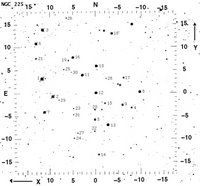It's my patch
 Click thumbnail for larger field of view
Click thumbnail for larger field of viewI imagine that I am not unique and that many observers have a special part of the sky that they relate to more intimately than others. For me, that is the stretch of sky from the Square of Cassiopeia out to the eye of Medusa in Perseus and the moving cluster around Mirfak. This part of the sky is rich and easy to navigate. In smaller scopes or even larger scopes under urban skies, open clusters are easy pickings. True, not all clusters jump out and bite but with some knowledge, expectation setting, and coaxing these are easy grabs for the samll scope or bright urban skies. One can appreciate the diversity that each one brings to your observing experience.
A host of catalogs identify a number of open clusters: Messier, Collinder, Stock, Trumpler, Dolidze, King, Basel, Czernik and more. I have mostly concentrated on NGC, Messier, Stock, and Trumpler open clusters.
I prefer to start my hop from the Square of Cassiopeia. The Square of Cassiopeia is the area of sky framed by beta-, alpha, gamma-, kappa Cas. When it is rising in the "Corridor" I can move up the sky to observe NGC 7789 on my way to M52. But tonight my first visit is NGC225. I starhop NE from gamma Cas past the mag 4.8 star leading to an arrangement of four stars that strikes me as a "pinwheel", this points right into NGC225. I'll use the pinwheel in the eyepiece coupled with NGC225 to establish an orientation which I can hop with ease to Stock24 and NGC189.
Peter Weinerroither records a beautiful image of NGC225, also dispayed on the cluster's WEBDA page.
 NGC225 is regular stop in the area since learning of it through Clark's book. He offers a list of open clusters that one can observe to estimate a telescope limiting magnitude (TLM). In the appendix of the book he provides two copies each cluster, one marked up with magnitudes and the other unmarked. One can find the same thing on the web at WEBDA. One can even interact with the cluster chart by changing chart parameters like V_mag.
NGC225 is regular stop in the area since learning of it through Clark's book. He offers a list of open clusters that one can observe to estimate a telescope limiting magnitude (TLM). In the appendix of the book he provides two copies each cluster, one marked up with magnitudes and the other unmarked. One can find the same thing on the web at WEBDA. One can even interact with the cluster chart by changing chart parameters like V_mag.The Saturday session's TLM was magnitude 13.2, on Sunday it was 12.6. At the time of Saturday's observation, Capella was rising above the tree line, her elevation about 10°. At mag 0 the difference in brightness is - what? Wow!
There's plenty more to see as we look over the galactic spur we're in across interarm space down onto the Perseus arm. The city sky from TotL does reveal an obvious Milky Way but through my optics the irregular nebulousity that glows softly, faintly, unmistakeably paints the background sky.
<< Home